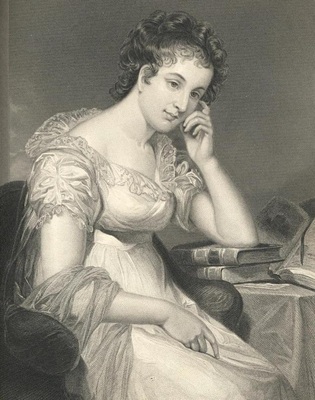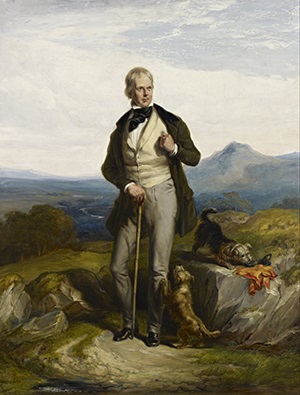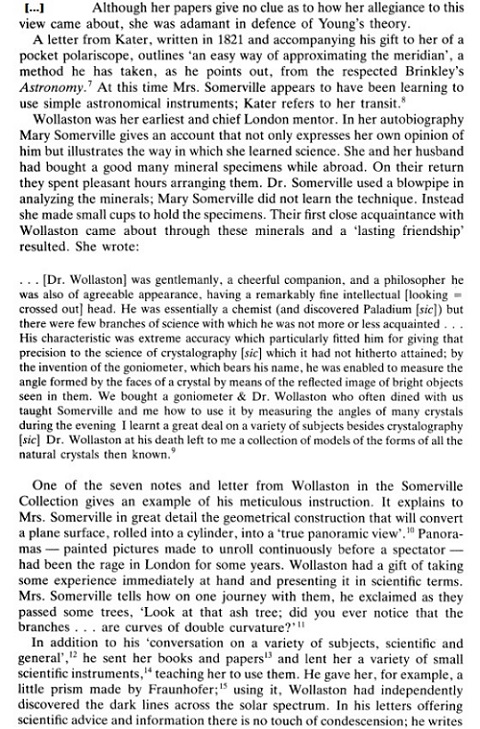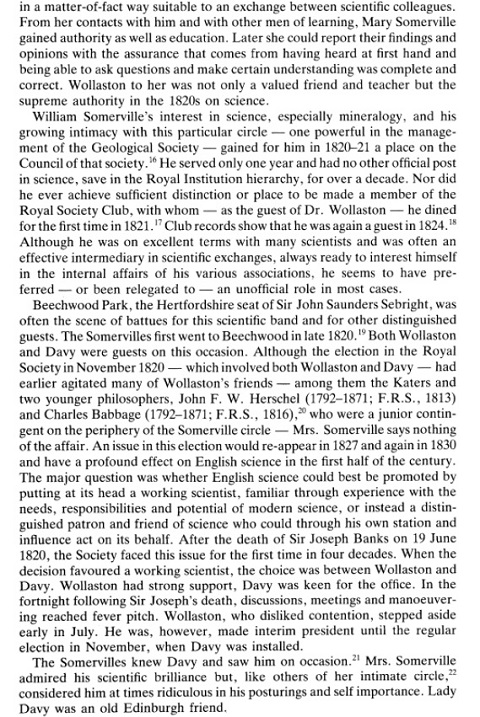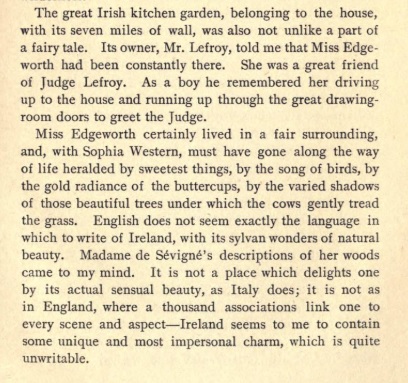Life
| b. 1 Jan. [New Year’s Day], Black Bourton [Blackbourton], nr. Reading, Oxfordshire; dg. Richard Lovell Edgeworth and his first wife Anna Elers (d.1772); ed. at school in Derby, 1775-80 [to aetat. 14], and afterwards in London, 1780-82; moves with her father and his wife Elizabeth [née Sneyd], to the estate he inherits at Edgeworthstown, Co. Longford - formerly and afterwards called Mostrim, having been associated with the family since 1583 - June 1782 (aetat. 15); issued Letters for Literary Ladies (1795), calling for educational reform; issues The Parents Assistant] (1796) - later reprinted in Drogheda (1802) - and Practical Education (1798), reflecting the liberal educational theories of her father and his circle, which included Thomas Day and Erasmus Darwin, and ultimately based on those of Rousseau in “Emile” - ideas modified by the disasterous effect of the system on his eldest son Lovell; |
| Maria becomes her father’s chief supporting in managing the estate, as well as teaching the children of his later marriages; believes in cultivating children’s memories by ‘well-arranged associations’ rather than rote; Edgeworths spared by United Irishmen during the Rebellion of 1798 on account of reputation as improving landlords; Edgeworthstown stoned by Orange mob after battle of Ballinamuck (which they visited), the windows being broken; Edgeworth’s fall under the suspicion of rebel sympathies and made ‘hostages at the inn’ in Longford; father and daughter visit the publisher Johnson in prison, where he served a six months sentence, summer 1799; her novella Castle Rackrent, purportedly the narrative of an ‘illiterate old steward’ Thady Quirk, and originally planned around a fictional family called “Stopgaps” - was published by Johnson in January 1800, appearing anonymously and probably intended as a contribution to the debate about the Union but greeted enthusiastically as the first regional novel - and expressly praised as such by Walter Scott; issued Belinda (1801) - modified under pressure in 1810 edn. to exclude the marriage between the black servant of a creole character and a white woman; |
| issued Moral Tales (1801); writes, with R. L. Edgeworth, an Essay on Irish Bulls (1802) - concerning ‘that which does not, and never did exist’ and claiming that the English spoken in Ireland is superior to that of England as still being ‘the language of Shakespeare’; Edgeworths travel abroad, staying at Brussels and Paris, 1802-03; Maria turns down marriage offer from Count [var. Chevalier] Abram Niclas Clewberg Edelcrantz, the private Secretary of the King of Sweden, whom she meets in the Netherlands, Dec. 1802, neither being willing to leave their own country and live in the other; a meeting with Lord Byron recorded by him in his correspondence [‘nice little unassuming [woman] if not handsome, certainly not ill-looking’’]; issues The Modern Griselda (1804); issues Leonora (1806), ded. to Count Edelcrantz; spends spent part of 1813 in London and find herself lionised there; issues Tales of Fashionable Life in 2 series [viz., 6 vols.], consisting of Ennui, The Dun, Manoeuvering, and Almeria (1st ser. 1809), and Vivian, The Absentee, Mme de Fleury, Emile de Coulanges (2nd ser. 1812); Patronage (1814) meets charges of impropriety from reviewers in altered climate; |
| publicly acknowledges her authorship of Castle Rackrent; reads Scott’s admiring ‘Postscript’ to Waverley (Chap. LXXII), containing praise of her, 23 Oct., 1814; issues Ormond (1817), written during her father’s last illness; death of Richard Lovell Edgeworth, 1817; issues Memoirs of R. L. Edgeworth (1820), and meets criticism for dated mentality; makes her second trip to Paris and finds herself warmly received in literary and social circles, in 1820; visits Scott at Abbotsford, 1823 and receives return visit at Edgeworthstown, Aug. 1825 - followed by a trip with him to Lakes of Killarney [infra]; Tales and Novels, in 14 vols. issued by [Hunter,] Baldwin & Cradock (London 1832); stayed at Beechwood, and later in London during Spring 1822 and passed time with the Marcets, Somervilles and Kater families, associating there with the renowned scientist William Hyde Wollaston; issues Helen (1834); |
| takes over management of Edgeworthstown from her brother Lovell Edgeworth, whom she pensions off and sends to England; he dies young and impecunious in America; issues Orlandino (1848), written for the Poor Relief Fund; helps to alleviate suffering during the Famine, paying for the importation of a flour and rice from Boston; suffers hunger along with her tenants; with others, signs petition for a Govt. pension eliciting a Civil List Pension of £200 for William Carleton, 1848; d. 22 May 1849, in few hours after falling ill with heart pains; and bur. in family vault, Edgeworthstown; some fragmentary notes associated with the composition of The Absentee are held in the Bodleian Library (MS Eng. e.1463); other papers are held in the National Library of Ireland; the papers of Maria Edgeworth are available on microfilm (Adam Matthew, 1995); there is a photo [Daguerrotype] of 25 May, 1841; some papers are held in the National Library of Ireland; The Absentee was produced in BBC3 in 9-11 May 2016 with Stephen Rea and Anna Healy. CAB ODNB JMC NCBE MKA ODQ RAF OCEL DIB DIW DIH DIL FDA OCIL |
|
| See page-images of Castle Rackrent, Preface (3rd edn. 1801)with associated text - as attached. |
[ top ]
Works| Original Works |
|
See also Oriental Tales [contains “Murad the Unlucky” (1804) with “Almoran and Hamet” (1761) by John Hawkesworth; “History of Nourjahad” (1767) by Frances Sheridan; “History of Charoba, Queen of Ægypt” (1785) by Clara Reeve. |
| Collected novels |
|
| Sundry reprints |
|
|
| [ top ] |
| The Novels and Selected Works of Maria Edgeworth, gen. eds., Jane Desmarais, Tim McLoughlin and Marilyn Butler; consulting ed., W.J. McCormack, 12 Vols. [Pickering Masters] (London: Pickering & Chatto 1999-2003) |
|
| —Source: COPAC [accessed online; 21.06.2010]; go to Pickerking & Chatto Publishers [online]. |
Popular Tales / by / Maria Edgworth, 3 vols. (London: J. Johnston), [with an introduction by R. L. Edgeworth, Edgeworth’s Town Feb. 1804 [pp.iv-viii], of which Vol. 1 contains “Lame Jervis” [Oct. 1799; p.1]; “The Will” [June 1800 p.129ff.]; “The Limerick Gloves” [p.237ff.; Nov. 1799]; “Out of Debt / Out of Danger” [Nov. 1801; 303-75 - available at Google Books]; Do. [2nd edn.], 3 vols. (London: Johnston [printed by C. Mercier] 1805), Do. [7th edn.] 3 vols. (London: for R. Hunter, Baldwin, Cradock & Joy; Longman, Hurst, Rees, Orme, & Brown; G. & W. B. Whittaker; and Simpkin & Marshal 1823) [printed by C. Baldwin] [of which Vol. 3 contains “The Lottery”; “Rosanna”; “Murad the Unlucky”; “The Manufacturers” - available at Google Books online]; also in Tales and Novels by Maria Edgeworth, 18 vols. (London: Baldwin & Cradock [for J. Murray, J. Booker, et mult. al.] 1832) [of which Vol. V reprints Popular Tales, Vol. II containing “Murid the Unlucky”, “The Manufacturers”, “The Contrast”, “The Grateful Negro”, “To-Morrow” - available at Google Books online]; Do. [another edn.], in Tales and Novels, in 9 vols. (London: Simpkin & Marshall [printed by Gilbert & Rivington] 1848), ill. [pls.] - of which Vol. II contains “Lame Jervis”, “The Will”, “The Limerick Gloves”, “Out of Debt Out of Danger”, “The Lottery”, “Rosanna”, “Murad the Unlucky”, “The Manufacturers”, “The Contrast”, “The Grateful Negro”, “To-Morrow” - ending on p.485].
CASTLE RACKRENT; / An / HIBERNIAN TALE / TAKEN FROM FACTS, / AND FROM / THE MANNERS OF THE IRISH SQUIRES, / BEFORE THE YEAR 1782 - BY MARIA EDGEWORTH / AUTHOR OF PRACTICAL EDUCATION, LETTERS FOR LITERARY / LADIES, THE PARENT’S ASSISTANT, &c. - THE FIFTH EDITION - LONDON: / PRINTED FOR J. JOHNSON AND CO. ST PAUL’S / CHURCHYARD - 1810. [verso and end-page:] H. Bryer, Printer, Bridge-Street, Blackfriars, London. Footnotes marked by * passim; a Glossary [ advertisement to the English reader] is affixed as pp.187-216 [following “Advertisement” and blank page]. Text: [Digital image of copy held in Bodleian Library, Oxford, available at Google Books online; accessed 09.07.2010; there is a copy in the RICORSO Library, “Irish Classics”, attached]
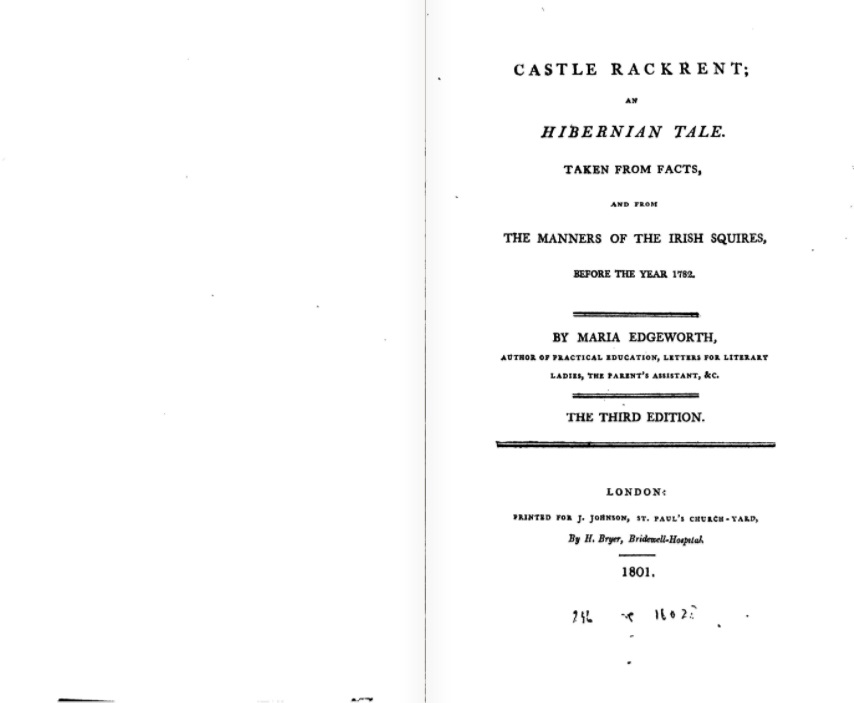 |
| Castle Rackrent [.... &c.] [3rd Edn.] (London: J. Johnson 1801) - see pages of Preface - as attached. |
[ top ]
| Castle Rackrent (1800) - some later editions | |
|
|
|
Readings on Poetry / by Richard Lovell Edgeworth and Maria Edgeworth (London: R. Hunter [...] 1816), xxviii, 212, [11]p., [2]-[11] advertisements); 15cm.; Do. [2nd Edn., corrected] (London: Published by R. Hunter (successor to J. Johnson,) ... and Baldwin, Cradock, and Joy, ..., 1816), xxviii, 212pp. [t.p. verso: H. Bryer, printer, ... London) [incls. Author’s Preface, pp.[iii]-xxviii, & ‘Correct list of Mr. and Miss Edgeworth’s works’, [pp.1-3 of 3rd sequence];
Tales of Fashionable Life, with a preface by R. L. Edgeworth, 6 vols. [2nd Edn.] (London: J. Johnston & Co. 1809-1812), Volume 1: Ennui; Volume 2: Almeria / Madame de Fleury / The Dun; Volume 3: Manoeuvring; Vol. 4: Vivian; Vol. 5: Emilie de Coulanges / The Absentee [Pt. 1]; Vol. VI: The Absentee [Pt. II]. Note: another edition [being the 4th, of which Vols. 4-6 are the 3rd Edn.] (London: Johnston 1813), and another edn. (1815). Also Do. [Microfilm] (British Library [1998]).
[The 1894 Macmillan Edition of The Absentee with an introduction by Anne Thackeray Ritchie and ills. by Chris Hammond is available as text and page images at Gutenberg Project - online; accessed 03.06.2018.]
Index of Publications available at Internet Archive with inks supplied by Clare County Library The life and letters of Maria Edgeworth, by Edgeworth, Maria
Published in 1895, Houghton, Mifflin & Co., Riverside Press (Boston & New York, Cambridge)
Contributions: Hare, Augustus J. C. 1834-1903.
Statement: edited by Augustus J. C. Hare ...
Pagination: 2 vols.
Available at Internet ArchiveTales from Maria Edgeworth
Published in 1903, W. Gardner, Darton & Co. ([London])
Statement: with introduction by Austin Dobson (1840-1921) and illustrations by Hugh Thomson (1860-1920).
Pagination: xxiv, 411, [1]pp.
Available at Internet ArchivePopular tales, by Edgeworth, Maria
Published in 1856, Simpkin, Marshall (London)
Statement: by Maria Edgeworth.
Pagination: 485 p., [3] leaves of plates:
Available at Internet ArchiveStories of Ireland
Castle Rackrent; The Absentee
by Edgeworth, Maria
Published in 1886, G. Routledge and Sons (London)
Contributions: Morley, Henry, 1822-1894.
Other titles: Castle Rackrent, The absentee.
Statement: by Maria Edgeworth; with an introduction by Henry Morley.
Series: Morley’s universal library — 36
Pagination: 287pp.
Available at Internet Archive
[ top ]
| Correspondence |
|
[ top ]
Sundry New Editions
|
[ top ]
Modern Collected Edition: Marilyn Butler & Mitzi Myers, gen. eds., The Works of Maria Edgeworth, 12 vols (London: Pickerting & Chatto 1997-2004), incls. all major fiction and some juvenile fiction with sel. of education and occas. writings.] - of which Vol. IX contains her drama [Love and Law; The Rose, Thistle and Shamrock; and Whim for Whim [unfinished].
Anthologies & Selections incl. “Murad the Unlucky”, in Robert E. Mack, ed., Oriental Tales (Oxford: OUP 1992), pp.215-56.
See also Christina Colvin, ‘Two Unpublished MSS by Maria Edgeworth’ [1. “Langan’s Defeat”; 2. “An Irish Wedding”], in A Revew of English Literature, ed. A. N. Jeffares, VIII, 4 (Oct. 1967), pp.53-61. [Extracts under Quotations, infra.]
Papers on microfilm: The Papers of Maria Edgeworth, 1768-1849 [on microfilm], Part I: The Edgeworth Papers from the Bodleian Library, Oxford, 23 reels 35mm. silver halide pos.; Pt. 2: The Edgeworth Papers from the National Library of Ireland, c20 reels [do.]; Pt. 3: Edgeworth Papers from Other Libraries, c10 reels [do.] (resp. £1,640, £1,400, and £700), with Guides. [Oxford St., Marlborough, Wiltshire, England, SN8 1AP.]
See also The Journals of Michael Pakenham Edgeworth (1812-1881) from the Bodleian Library [India in the Age of Empire], Guide, 40pp. - and note; A photo-portrait of Michael Pakenham Edgeworth (1812-81), a younger half-brother of Maria Edgeworth, dating from c.1843 and possibly taken by himself, is deemed to be among the earliest extant such photos in Ireland . See Irish Photography Museum > Timeline - online [accessed 21.10.2023]. His calotype image of Edgeworthstown House dates from the same period.
Miscellaneous, G. R. Neilson, The Book of Bulls. Being a Very complete and Entertaining Essay on the Evolution of the Irish and other “Bulls”. With which is Included “Essay on Irish Bulls”, by the Edgeworths, published Early in the Century (London: Simkin, Marshall, Hamilton, Kent & Co. Ltd., and George Tucker 1898).
[ top ]
Criticism
|
See also introductions to several of her works written by A. N. Jeffares (1953), George Watson (1964), and W. J. McCormack (1988), as well as discussions in Thomas Flanagan, The Irish Novelists (1959), McCormack, Ascendancy and Tradition (1985), B. G. MacCarthy, The Female Pen: Women Writers and Novelists 1621-1818 (Cork UP 1994); Kit & Cyril Ó Céirnín, Women of Ireland: A Biographical Dictionary (Kinvara: Tír Eolas 1996); and Vera Kreilkamp, Anglo-Irish Novel and the Big House (Syracuse UP; Eurospan 1999).
|
[ top ]
Bibliographical details[ top ]
Commentary
See separate file [infra].
[ top ]
Quotations
See separate file [infra].
[ top ]
References| There is an Edgeworth page online at TINET [link] |
D. J. O’Donoghue, Poets of Ireland (Dublin: Hodges Figgis 1912) lists Comic Drama in Three Acts (London 1817) Dramas and Dialogues by M.E. [anon] (1860); work included in Samuel Lover’s Poems of Ireland, Hercules Ellis’s Songs of Ireland. IF lists Tales and Miscellaneous Pieces (1848); Castle Rackrent (1800); The Absentee (1807) [err. for 1812]; Ennui (1809); Ormond (1817); Tales from Maria Edgeworth (1912); Miss Edgeworth’s Irish Stories (1918).
Peter Kavanagh, The Irish Theatre: Being a History of the Drama in Ireland from the Earlieest Period up to the Present Day (Tralee: The Kerryman 1946), lists three plays in Comic Dramas (1817), none acted; Love and Law, set in Ireland with dialect; The Two Guardians, com. set in England; and The Rose, Thistle and Shamrock, incl. sentimental portrayal of Irishman. C. G. Duggan, The Stage Irishman (1937) cites Maria Edgeworth’s plays, Love and Law, and The Rose, Thistle and Shamrock, both of which Duggan describes as sound peasant comedy. Brown, Guide to Books on Ireland, cites Maria Edgeworth (Love and Law, et al. printed London 1817).
Brian McKenna, Irish Literature, 1800-1875: A Guide to Information Sources (Detroit: Gale Research Co. 1978), cites Marilyn Butler, Maria Edgeworth (OUP 1972); James Newcomer, Maria Edgeworth [Irish Writers Series] (Lewisburg: Bucknell 1973); Frances Anne Edgeworth, A Memoir … with selection from her letters (1867); Grace A. Oliver, A Study (Boston 1882); Emily Lawless, Maria Edgeworth (1904); The Black Book of Edgeworthstown, ed. Harriet Jessie Butler (1927), et al. Criticism cited includes George Saintsbury (Macmillan’s Magazine, 1895), Padraic Colum (British Review, 1915), Roger McHugh (Studies 1938), Honor Tracy (Bell, 1946), and Patrick Murray (Studies, 1970). NOTE, Irish Bulls is ascribed to her alone in McKenna’s Bibliography.
Patrick Rafroidi, Irish Literature in English: The Romantic Period, 1789-1850 (Gerrards Cross: Colin Smythe 1980), Vol. 2, cites as authoritative Bertha Coolidge Slade, Maria Edgeworth 1767-1849, A Bibliographical Tribute (London 1937) 253pp. Also studies by Helen Zimmern (1883), Augustus Hare (1894), Constance Hill (1910), Isabel Clarke (1949); H. W. Hausermann (1952), Elisabeth Inglis-Jones (1959), O. Elizabeth McWhirter Harden (1965), James Newcomer (Bucknell 1973), Michael Hurst (1969), Patrick Murray (in Studies 1970); Christina Colvin (1971); Patricia Lynch (1972), and several unpublished theses.
Seamus Deane, ed., The Field Day Anthology of Irish Writing, gen. ed. (Derry: Field Day 1991), Vol. 1, devotes a full section to Maria Edgeworth [ed. W. J. McCormack], and extracts from Castle Rackrent; An Essay on Irish Bulls; The Absentee; Letter to Michael Pakenham Edgeworth [‘It is impossible to draw Ireland as she now is in a book of fiction (… &c.; 19 Feb. 1834)’, [1011-51]; also 1051-52, BIOG & COMM [as above].
George Watson, ed., Castle Rackrent, An Hibernian Tale, taken from facts, and from the Manners of the Irish Squires, before the Year 1782 [World Classics (OUP 1964, reps. to 1989), cites R. F. Butler, ‘Maria Edgeworth and Sir Walter Scott, Some Unpublished Letters, 1823’, Review of English Studies, n.s., ix (1958); also ref. in The Farington Diary [held at Windsor], ed. James Greig, Vol. VIII (London 1928); Watson also cites edns. of Castle Rackrent with introductions by Anne Thackeray Ritch[i]e (1895), Brander Matthews (Everyman 1910), both with The Absentee; and A N Jeffares (Edin 1953). Sources include A Memoir of Maria Edgeworth, with a Selection from her Letters by the late Mrs [Frances] Edgeworth, 3 vols. (1867) [priv. printed]; Augustus J. C. Hare, The Life and Letters of Maria Edgeworth, 2 vols. (1894); F. V. Barry, ed. and intro., Maria Edgeworth, Chosen Letters (London: Jonathan Cape 1931) [contains letters in Geneva]; also letters in possession of Mrs Margaret Butler, Richmond, Surrey, and NLI, Memoirs of Richard Lovell Edgeworth, 2 vols. (1820) [completed by Maria]; H. J. and H. E. Butler, The Black Book of Edgeworthstown and other Edgeworth Memoirs, 1585-1817 (1927); commentaries include Hon. Emily Lawless (1904); P. H. Newby, Maria Edgeworth (1950); Isabel C. Clarke, Maria Edgeworth, Her Family and Friends ([1950]; Elisabeth Inglis-Jones, The Great Maria (1959); Bertha Coolidge Slade, Maria Edgeworth, A Bibliographical Tribute (1937) [ltd. ed.]. Watson (1964) also acknowledges assistance of Mrs Margaret Butler, widow of Harold Edgeworth Butler; Marilyn Butler, author of forthcoming study; Mrs. Christina Colvin of Oxford, et al.
Rolf & Magda Loeber, with Anne Mullin Burnham, A Guide to Irish Fiction, 1650-1900 (Dublin: Four Courts Press 2006) - Introduction: ‘[...] Richard Lovell Edgeworth and Maria Edgeworth noted that “General principles of taste and criticism have been spread in society by reviews and magazines”. (Edgeworths, Readings on Poetry, London, 1816; 2nd corr. edn., pp.xix-xx; here p.lxiii.)
Shell Guide to Ireland, ed. Lord Killalin [Morris] (1966) lists in Mostrim [Meathas Troim], Longford, Edgeworthstown House, home of family for 400 years; visited by Scott, 1825, by Wordsworth, 1829.
[ top ]
Libraries & Booksellers
Long Room (TCD LIbrary 1978) lists Practical Education, 2nd edn. in 3 vols. (London: for J. Johnston by J. Crowder 1801), 3 pls. (fold), 8o.
ODNB , 7th Imp., corrects ‘letters to’ to ‘letters for’.) Further, ‘A prize essay on Ennui was read to the Academy of Berlin, which put all the judges to sleep!’ [title unnamed and unknown, cited by Marilyn Butler.]
Belfast Public Library holds Belinda (1848); Castle Rackrent and The Absentee (1895); Castle Rackrent; Essay on Irish Bulls; Noble Science of Self-Justification, Ennui and The Dun (1848); Comic Dramas in three acts (1817); Forgive and Forget, and Rosanna, translated into Irish for the Ulster Gaelic Soc. by Thomas Feenachty (1833); Harrington,; Thoughts on Bores, and Ormond (1848); Harry and Lucy concluded (1825); Helen (1848); Irish Tales (n.d.); Manoeuvring; Almeria, and Vivian (1848); Moral Tales (1820, 1849); Ormond (1817); Patronage, Comic Dramas, Leonora, and Letters, 2 vols. (1848); Popular Tales (1848); Stories of Ireland; Castle Rackrent, and The Absentee (1886); Tales and Miscellaneous pieces, 14 v. (1825); Tour in Connemara (1950); Essay on Irish Bulls (1802); Memoirs of Richard Lovell Edgeworth (1820). has extensive holdings.
University of Ulster, Morris Collection holds Forgive and Forget, and Rosanna (1833); Selections from her Works (Dublin: Talbot c.1920), 419p.; Selected Tales (Dublin: Browne & Nolan 1906).
De Burca: Maria Edgeworth’s library contained J. C. Curwen, Observations on the State of Ireland, principally directed to its Agriculture and Rural Population; in a series of Letters, written on a tour of that country, 2 vols. (London: Baldwin, Cradock, and Joy, 47, Paternoster-Row, 1818) [1] xx, 435pp.; xii, 355pp. listed as Maria Edgeworth’s copy at De Burca Rare Books (Oct. 2024) [Original half-calf on marbled boards, title in gilt on red morocco labels on spine; presentation inscription on titlepage "Miss Edgeworth / from the author". Very scarce
[ top ]
Notes
Practical Education (1798) is usually attributed to Maria Edgeworth. Yet she explicitly writes in her Memoirs of R. L. Edgeworth (1821) that the pedagogic text was begun by R.L.E. with Mrs. Honora Edgeworth in 1778: ‘[…] being the first part of ‘Harry and Lucy’ or of Practical Education, as I [M.E.] find it called in the titlepage … printed literally for his own children and not published for many years afterwards.’ The Memoirs are not so much an edition of her father’s writings as a recasting of his autobiography - written at the behest of a son - in the form of a 3rd person biographical narrative.
Colambre?: John Nugent of Castle Nugent Culambre was a br. of Grace Nugent, the object of Carolan’s poem, cited as such in a letter of Charles O’Conor to J. C. Walker (see Letters, ed. Ward & Ward, 1988, p.455.) Note that this connection with the principal character of The Absentee is carefully elaborated by J. W. McCormack in his Oxford Classics edition of the work.
Punctuated: The daughter of Sir Edward Codrington 1770-1851) of Trafalgar and Navarino (where he was the victor), has left a description of his powdering while his would stand reading to him ‘one of Miss Edgeworth’ charming little stories’, her father correction her punctuation as she did so. (See Paul Johnson, ‘To Hell with Picasso’, London: Weidenfeld & Nicolson 1996, q.p.) Note: There is a life of Sir Edward Codrington (Memoir of the life of Admiral Sir Edward Codrinfton ... &c., ed. by his daughter Lady [Jane] Bourchier, 1873, 2 vols.; ded. To the memory of a dear and honoured father from a loving and grateful daughter; available at Internet Archive - online; accessed 22.12.2017.)
John Wilson Croker’s anonymous Intercepted Letter from Canton (1804) is the source of Maria Edgeworth’s account of the post-Union middle class in The Absentee, according to W. J. McCormack (see under Croker, q.v.).
[ top ]
Sir Walter Scott (1771-1832)
|
[ top ]
G. R. Neilson, The Book of Bulls: Being a Very complete and Entertaining Essay on the Evolution of the Irish and other “Bulls”. With which is Included “Essay on Irish Bulls”, by the Edgeworths, published Early in the Century (London: Simkin, Marshall, Hamilton, Kent & Co. Ltd., and George Tucker 1898). The editor claims that his omitsasp aspects of the Edgeworth text which editor considers ‘censorious - even ill-natured’ and publishes only its stories - not its comments or moralising’, adding fifty pages of fresh bulls ‘to bring the collection made by Dr. [sic] and Miss Edgeworth up to date’ (p.147; cited in Martin J. Croghan, ‘Maria Edgeworth and the Tradition of Irish Semiotics’, in Donald E. Morse, et al., eds., A Small Nation’s Contribution to the World, Gerrards Cross: Colin Smythe, 1993, pp.194-206.)
[ top ]
B. G. MacCarthy discusses Edgeworth, inter al., under the following chapter-headings of The Female Pen: Women Writers and Novelists 1621-1818 (Cork UP 1994): ‘The Oriental Novel’ (Chap. IX), and ‘The Didactic Novel with Prominent Local Colour’ (Chap. XII). Bibl. includes Constance Hill, Maria Edgeworth and her Circle in the Dayes of Bonaparte and Bourbon (1910); Emily Lawless, Maria Edgeworth (1904); A. H. Patterson, The Edgeworths (Univ. Tutorial Press 1914); Harriet Jessie Butler and Harold Edgeworth Butler, eds., The Black Book of Edgeworthstown and Other Edgeworth Memoirs 1585-1817 [sic] (1927); Helen Zimmern, Maria Edgeworth [Eminent Women Ser.] (1883).
Essay on Irish Bulls, account of author’s object, being ‘[to] succeed in diffusing a more just and enlarged idea of the Irish’ (Garland ed., 1979, p.315).
Mary Campbell (d.2001), wife and widow of Flann Campbell [son of Joseph Campbell] owned a copy of the work of Madame de Genlis with Maria Edgeworth’s signature on the front papers. Mary and Flann settled on Green Rd., Blackrock, Co. Dublin in the 1980s after many years London. He was a teacher and a published writer on Ulster presbyterian nationalists and a life-long member of Marxist groups in London.
Tom Paulin: Paulin takes Thady in Castle Rackrent to be a parody of Edmund Burke. (See Declan Kiberd, review of The Day-Star of Liberty: William Hazlitt’d Radical Prose, in Irish Times, 13 June 1998, Weekend.)
First Flush notice of Daire Keogh & Kevin Whelan, Acts of Union: The Causes, Contexts and Consequences of the Act of Union (Dublin: Four Courts Press 2001), refers to Castle Rackrent: ‘The metaphor of a bad marriage […] is reflected in the text and on the cover [of Keogh & Whelan]. For instance in one essay the domineering patriarch is discussed with relation to Maria Edgeworth and her father. Her revenge is seen as being Castle Rackrent and Ennui that depict characters Kit and Jessica, Isabella and Condy, Glenthorn and Geraldine who are as mismatched in their unions as oil and vinegar. (Books Ireland, Feb. 2002, p.33.)
[ top ]
The great cloak (1): Standish O’Grady claimed in Ulrick The Ready (1899) that the wearing of what was called the Irish cloak - opprobriously mentioned in the first note to Castle Rackrent (1800) - was a custom learned from a previous generation of English colonist, viz., Richard Plantagenet (q.p.)
The great cloak (2): W. B. Yeats commences his story, “Proud Costello, the Daughter of MacDermott and the Bitter Tongue”, in The Secret Rose (1897) with the sentence: ‘Costello had come up from the fields and lay upon the ground before the door of his square tower, resting his head upon his hands and looking at the sunset, and considering the chances of the weather. Though the customs of Elizabeth and James, now going out of fashion in England, had begun to prevail among the gentry, he still wore the great cloak of the native Irish’ (See Early Poems and Stories, Macmillan 1925, p.376.)
Big House: Christine Case & Alistair Rowan, The Buildings of Ireland, North Leinster (Penguin), in the Pevsner architectural series, remarks that Castle Rackrent in Edgeworth’s novel is said to be modelled on Tristernagh Abbey, and characterises laissez faire attitude of successive Irish governments to architectural heritage as a ‘perfect, inexcusable waste’.
Portrait: There is an ink portrait in profile by James Slater. (See Nicola Trott, ‘Henglishwoman from Hoxfordshire’, review of Sharon Murphy, Maria Edgeworth and Romance, and Clíona Ó Gallchoir, Maria Edgeworth: Women, Enlightenment and Nation, in Times Literary Supplement, 6 Jan. 2005).
[ top ]
Scientific daze: Melvyn C. Usselman cites a letter of ME to Mrs Edgeworth, Jan 16, 1822 (in Colvin, Letters from England, p.321) in his life of Edward Wollaston - where Maria Edgeworth tells of two meetings with Wollaston and his character [‘esteemed, beloved, admired .. by all who knew him.’ (p.7.) Further remarks on a stay in Beechwood - the home of Sir John Saunders Seabright - and later London of 1822, when she met Wollaston at the homes of the Marcets, Somervilles, and Kater families. See Usselman, Pure Intelligence: The Life of William Hyde Wollaston (Chicago UP 2015), p.7, 327f. Also cites MacCormack [sic], ‘Edgeworth, Maria, 1768-1849’, oDNB [Notes].
| Judge Lefroy [Thomas Langlois Lefroy, Chief Justice of Ireland] | |||
|
|||
| See further under Lefroy - infra. |
[ top ]
